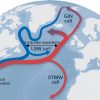Hurricane Beryl has intensified into an “extremely dangerous” Category 4 storm as it nears the southeast Caribbean, prompting widespread precautionary measures and urgent calls for shelter.
On Sunday morning, Beryl escalated to a Category 3 hurricane, marking the earliest occurrence of a major hurricane east of the Lesser Antilles in June, according to Philip Klotzbach, a hurricane researcher from Colorado State University.
The rapid intensification of Beryl, which transitioned from a tropical depression to a major hurricane in just 42 hours, is a rare meteorological event, with only six similar occurrences recorded in Atlantic hurricane history.
This makes Beryl the earliest Category 4 hurricane on record, surpassing Hurricane Dennis, which achieved Category 4 status on July 8, 2005.

Currently, Beryl is positioned approximately 335 miles east-southeast of Barbados, with maximum sustained winds of 130 mph and moving westward at 21 mph.
The compact storm has hurricane-force winds extending only 15 miles from its center. Hurricane warnings are in effect for Barbados, St Lucia, Grenada, St Vincent, and the Grenadines, with a tropical storm warning also issued for Martinique and a tropical storm watch in effect for several other Caribbean regions.
Residents are bracing for life-threatening conditions, including storm surges of up to 9 feet and heavy rainfall. Authorities have reported long lines at gas stations and grocery stores as people prepare for the storm.
Caribbean leaders are urging everyone to take the threat seriously, with Barbados Prime Minister Mia Mottley and St Lucia Prime Minister Philip J. Pierre announcing national shutdowns and closures of businesses and schools to prioritize safety.
As Beryl continues its path toward the Caribbean Sea and Mexico, the storm remains a significant threat, with forecasters closely monitoring a cluster of thunderstorms trailing behind that may develop into a tropical depression.

